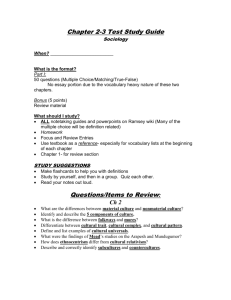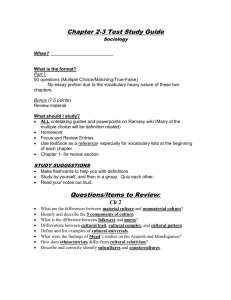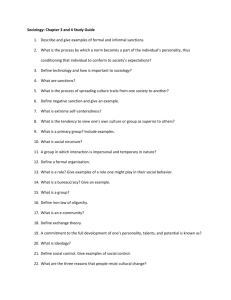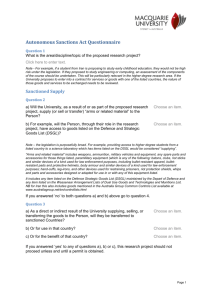Sanctions Activities Compliance Form
advertisement
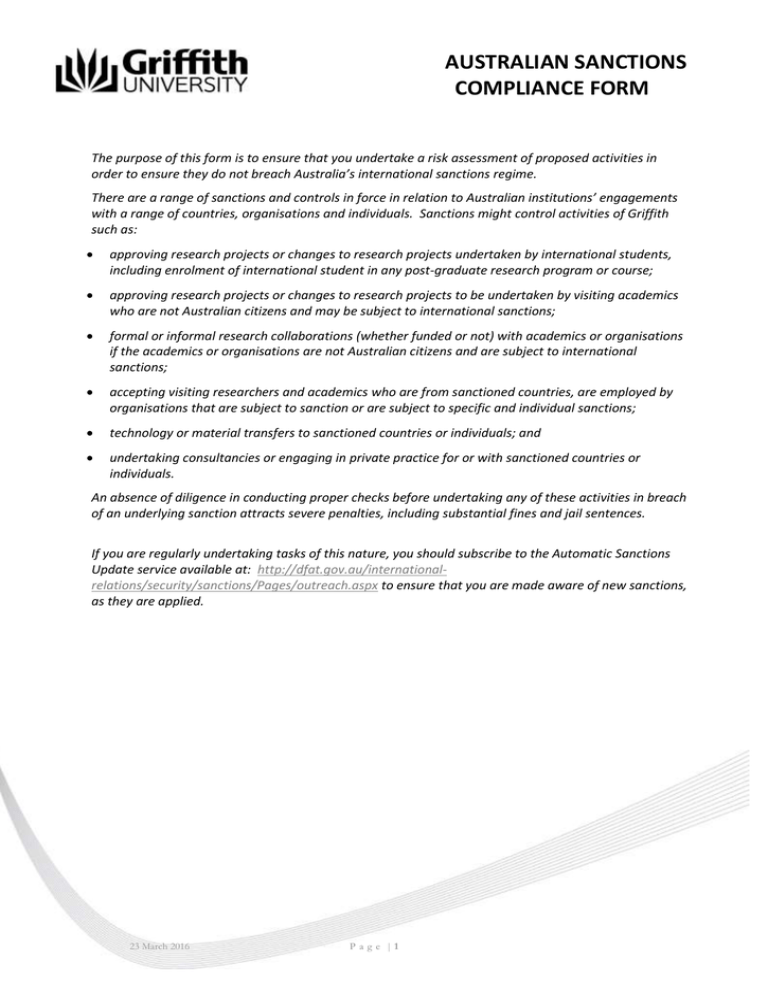
AUSTRALIAN SANCTIONS COMPLIANCE FORM The purpose of this form is to ensure that you undertake a risk assessment of proposed activities in order to ensure they do not breach Australia’s international sanctions regime. There are a range of sanctions and controls in force in relation to Australian institutions’ engagements with a range of countries, organisations and individuals. Sanctions might control activities of Griffith such as: approving research projects or changes to research projects undertaken by international students, including enrolment of international student in any post-graduate research program or course; approving research projects or changes to research projects to be undertaken by visiting academics who are not Australian citizens and may be subject to international sanctions; formal or informal research collaborations (whether funded or not) with academics or organisations if the academics or organisations are not Australian citizens and are subject to international sanctions; accepting visiting researchers and academics who are from sanctioned countries, are employed by organisations that are subject to sanction or are subject to specific and individual sanctions; technology or material transfers to sanctioned countries or individuals; and undertaking consultancies or engaging in private practice for or with sanctioned countries or individuals. An absence of diligence in conducting proper checks before undertaking any of these activities in breach of an underlying sanction attracts severe penalties, including substantial fines and jail sentences. If you are regularly undertaking tasks of this nature, you should subscribe to the Automatic Sanctions Update service available at: http://dfat.gov.au/internationalrelations/security/sanctions/Pages/outreach.aspx to ensure that you are made aware of new sanctions, as they are applied. 23 March 2016 P a g e |1 Australian Sanctions Compliance Form Name of person completing form: Name of person/entity concerned (include Griffith ID): Project/Activity: Date: STEP 1 - Identifying risks at a glance 1. Weapons of Mass Destruction Does the arrangement or project involve activity you believe or suspect on reasonable grounds may assist with a Weapons of Mass Destruction Program? Yes. - include further details No. Note: A weapons of mass destruction program is a plan or program for the development, production, acquisition or stockpiling of nuclear, biological or chemical weapons or missiles capable of delivering such weapons. 2. Arms and Arms Related Materiel Does the arrangement/project involve Arms or Arms Related Materiel? Yes. - include further details No. Note: Arms and Arms Related Materiel is weapons, ammunition, military vehicles and equipment, or their spare parts or accessories, and paramilitary equipment. P a g e |2 Australian Sanctions Compliance Form 3. Prohibited Persons and Entities The Department of Foreign Affairs and Trade keeps the Consolidated List, a list of all persons and entities who are subject to targeted financial sanctions or travel bans under Australian sanctions laws. You can access the Consolidated List through http://www.dfat.gov.au/sanctions/consolidated-list.html and you can search it using the control-F function. You should also conduct a search of the Consolidated List to ascertain whether or not the relevant person has studied at or worked with an organisation that is on the Consolidated List. A particular individual from a country subject to sanctions may themselves be subject to sanctions even if their name is not on the Consolidated List. You should review the following list of Sanctioned Countries to see if the person involved is a resident or citizen of, or has a connection with any of them: *Central African Republic *Côte d'Ivoire *Democratic Republic of Congo *DPRK (North Korea) * Eritrea *Former Federal Republic of Yugoslavia *Guinea – Bissau *Iran * Iraq *Lebanon *Liberia *Libya *Myanmar/Burma *Russia, Crimea and Sevastopol *Somalia *Syria *Sudan *Ukraine *Yemen *Zimbabwe1 Does the arrangement/project involve a: Person or entity situated in a Sanctioned Country? Citizen/national of a Sanctioned Country without Australian citizenship or permanent residency status? Sanctioned country? A prohibited person/entity? Yes. No Yes. Yes. Yes. No No No If yes, include further details If you answered yes to only Q1, go directly to Step 3 If you answered yes to Q2 or Q3, go to Step 2 If you answered no to all questions in Step 1, go to Step 4 STEP 2 – Eliminating risk of application of Australian Sanctions Law Answer all questions in Step 2 4. Prohibited Persons and Entities To assess if the arrangement/project could involve a potential benefit to a Prohibited Person or Entity answer the following questions by using the control-F function to search against the Consolidated List which you can access at http://www.dfat.gov.au/sanctions/consolidated-list.html : (please select if applicable): Is the student (if any) a Prohibited Person? Yes. No Is the student’s sponsor (if any) a Prohibited Person or Entity? Yes. No Is the staff member or visitor (if any) a Prohibited Person? Yes. No 1 Current as at 20 August 2014. P a g e |3 Australian Sanctions Compliance Form Is a research collaborator or proposed recipient of information involved in the arrangement/project (if any) a Prohibited Person or Entity? Is a funding body (if any) a Prohibited Person or Entity? Is the student, staff member, visitor or collaborator an employee or representative of a Prohibited Person or Entity? Has the student, staff member, visitor or collaborator been an employee or representative of a Prohibited Person or Entity? Yes. Yes. No No Yes. No Yes. No If yes, insert the name of the Prohibited Person or Entity and their role in the project/arrangement. If the association with the Prohibited Person or Entity is an historical one, are you satisfied that there is no continuing association and, if you are not satisfied there is no continuing association, insert the name of the Prohibited Person or Entity and the nature of the historical relationship? 5. Arms and Arms Related Materiel To assess if the arrangement/project could provide a Sanctioned Country (see list in Q3) with sanctioned technical advice, assistance or training, or financial assistance or another service, does the arrangement/project relate to (please select if applicable): A military activity OR Arms or Arms Related Materiel (weapons, ammunition, military vehicles and equipment, spare parts or accessories and paramilitary equipment) If either is selected: Is there a student/sponsor/staff member/visitor/research collaborator/recipient of information from a Sanctioned Country (see list in Q3)? If yes, insert the name of the person/entity, specify the Sanctioned Country, specify the military activity or Arms or Arms Related Materiel involved, and attach a detailed description of the project explaining the role of the named person and entity: P a g e |4 Australian Sanctions Compliance Form 6. Iran, North Korea & Syria Does the arrangement/project involve a person or entity situated in or a citizen/national of the following country and who does not hold Australian citizenship or permanent residency status: Iran (Go to A) North Korea (Go to B) Syria (Go to C) (A) IRAN To assess if the arrangement/project could involve sanctioned activity for Iran you must review the items in each of the lists at the following links and indicate if any items on the list will be, or have the potential to be, involved in the arrangement/project. In making this assessment you must try to anticipate all foreseeable changes to the project arrangement until completion. You cannot answer this question without going to each URL and reviewing the full list. INFCIRC/254/Rev.12/Part 1at https://www.iaea.org/sites/default/files/publications/documents/infcircs/1978/infcirc254r12p1.pdf which deals with export of nuclear materials, equipment and technology and corresponding training noting that the export or training may be approved by the United Nations Security Council. Note that an approval in advance by the Security Council shall not be required for the supply, sale, or transfer to Iran of: equipment covered by Section B.1 of INFCIRC/254/Rev.12/Part 1 when such equipment is for light water reactors; low-enriched uranium covered by A.1.2 of INFCIRC/254/Rev.12/Part 1 when it is incorporated in assembled nuclear fuel elements for such reactors; as well as items, materials, equipment, goods and technology set out in INFCIRC/254/Rev. 9/Part 2 only when for exclusive use in light water reactors. INFCIRC/254/Rev.9/Part 2 at https://www.iaea.org/sites/default/files/publications/documents/infcircs/1978/infcirc254r9p2.pdf which deals with transfer of nuclear-related dual-use equipment, materials, software and related technology and corresponding training noting that the export or training may be approved by the United Nations Security Council. Note that an approval in advance by the Security Council shall not be required for the supply, sale, or transfer to Iran of: equipment covered by Section B.1 of INFCIRC/254/Rev.12/Part 1 when such equipment is for light water reactors; low-enriched uranium covered by A.1.2 of INFCIRC/254/Rev.12/Part 1 when it is incorporated in assembled nuclear fuel elements for such reactors; as well as items, materials, equipment, goods and technology set out in INFCIRC/254/Rev. 9/Part 2 only when for exclusive use in light water reactors. S/2015/546 at https://disarmamentlibrary.un.org/UNODA/Library.nsf/6d9eec6cdd36149b85257ddc006cd868/e7551f39803265f285257e92005b6a0c/$FILE/S%20 2015%20546.pdfwhich deals with items, materials, equipment, goods and technology related to ballistic missile-related programs capable of delivering nuclear weapons together with any items, materials, goods and technology that the State determines could contribute to the development of nuclear weapons delivery systems. The annex to A/RES/46/36 L dated 6 December 1991 at http://www.un.org/Depts/ddar/Register/4636.html which deals with arms and related materiel. Autonomous Sanctions (Export Sanctioned Goods – Iran) Amendment Specification 2016 at https://www.comlaw.gov.au/Details/C2016G00073 which deals with: P a g e |5 Australian Sanctions Compliance Form - - high grade steel with a chromium content, raw or semi-fabricated graphite, nickel and nickel alloys, aluminium and aluminium alloys and certain other base metals and cermets; and - enterprise resource planning software specifically for use in nuclear and military industries As required by DFAT, if you have ticked any box above you must: 1. Provide details of the “export sanctioned good” that the university has identified the student may use as part of his or her proposed research. 2. Provide an explanation of how he or she may use those goods. 3. Provide a list of items you have considered in conducting this risk assessment, and specify why each item is not caught by the sanctioned goods lists above. P a g e |6 Australian Sanctions Compliance Form (B) NORTH KOREA To assess if the arrangement/project could involve sanctioned activity for North Korea you must review the items in each of the lists at the following links and indicate if any items on the list will be, or have the potential to be, involved in the arrangement/project. In making this assessment you must try to anticipate all foreseeable changes to the project arrangement until completion. You cannot answer this question without going to each URL and reviewing the full list. S/2012/235 at http://www.un.org/ga/search/view_doc.asp?symbol=S/2012/287 which deals with items, materials, equipment, goods and technology related to nuclear programmes. S/2009/205 at http://www.un.org/ga/search/view_doc.asp?symbol=S/2009/205 which deals with items, material, equipment, goods and technology related to ballistic missile programmes. S/2006/853 at http://www.un.org/ga/search/view_doc.asp?symbol=S/2006/853 which deals with chemicals and biological items, materials, equipment, goods and technologies related to other weapons of mass destruction programs. INFCIRC/254/Rev.9/Part1a at http://www.un.org/ar/sc/committees/1737/pdf/INFCIRC1.pdf which deals with expert of nuclear material, equipment and technology. INFCIRC /254/Rev.7/Part2a at http://www.un.org/sc/committees/1737/pdf/INFCIRC_254_Rev.7_Part2.pdf which deals with transfer of nuclear related dual use equipment, materials, software and related technology. S/RES//1718 subparagraph 8(a)(i) and (ii) at http://www.un.org/ga/search/view_doc.asp?symbol=S/RES/1718%20(2006) which deals with arms and related materiel. 1. Provide details of the “export sanctioned good” that the university has identified the student may use as part of his or her proposed research. 2. Provide an explanation of how he or she may use those goods. 3. Provide a list of items you have considered in conducting this risk assessment, and specify why each item is not caught by the sanctioned goods lists above. P a g e |7 Australian Sanctions Compliance Form (C) SYRIA To assess if the arrangement/project could involve sanctioned activity for Syria you must review the items in each of the lists at the following links and indicate if any items on the list will be, or have the potential to be, involved in the arrangement/project. In making this assessment you must try to anticipate all foreseeable changes to the project arrangement until completion. You cannot answer this question without going to each URL and reviewing the full list. Autonomous Sanctions (Export Sanctioned Goods – Syria) Designation 2012 at http://www.comlaw.gov.au/Details/F2013C00665 which deals with materials, chemicals, micro-organisms and toxins and materials processing. Autonomous Sanctions (Export Sanctioned Goods – Syria) Specification 2012 at http://www.comlaw.gov.au/Details/C2014G00119 which deals with: - - exploration and production of crude oil and natural gas - refining of crude oil and liquefaction of natural gas - petrochemical industry - equipment or technology to be used in the construction or installation of power plant for electricity production - equipment, technology or software which may be used for the monitoring or interception of internet or telephone communications - luxury goods 1. Provide details of the “export sanctioned good” that the university has identified the student may use as part of his or her proposed research. 2. Provide an explanation of how he or she may use those goods. 3. Provide a list of items you have considered in conducting this risk assessment, and specify why each item is not caught by the sanctioned goods lists above. P a g e |8 Australian Sanctions Compliance Form 7. Provision of Sanctioned Goods The transfer of items listed on the Defence and Strategic Goods List from Australia to a place outside Australia (except to the United States defence community) is prohibited except where a permit has been issued by the Defence Trade Controls Office within the Department of Defence. The Defence and Strategic Goods List is available for download from http://www.comlaw.gov.au/Details/F2013C00665. Does the arrangement involve the export of an item listed on the Defence and Strategic Goods List? If you ticked any question in Step 2, go to Step 3. If you have not been prompted to tick any questions in Step 2, go to Step 4. STEP 3 – Where a risk has been identified There is a substantial risk that the arrangement/project may not comply with Australian Sanctions Laws. If you wish to proceed with the arrangement/project and possibly seek a permit for it, you should complete Annexure A – Risk Matrix ranking the proposed arrangement or project as Low Risk, Medium Risk or High Risk and stating which of the applicable consequent Outcomes you consider appropriate. You should then refer the completed and signed Sanctions Compliance Form to the appropriate Group Dean (Research). The Group Dean (Research) may convene a Group Sanctions Review Panel comprised of the relevant Head of School and/or other designees selected by the Dean (Research) versed in the subject matter of the proposed research proposal to consider what further action, if any, is appropriate, or whether or not further advice should be sought in relation to the activity. STEP 4 – Where no risk is identified The arrangement/project should comply with Australian Sanctions Laws and can proceed. P a g e |9 Australian Sanctions Compliance Form STEP 5 – Declarations Supervisor/Researcher Declaration Name: _______________________________________ Position: _______________________________________ By submitting this form I declare that: I am aware of the University Sanctions Policy and, if this form relates the admission of a student to a research program, the HDR and Other Research Programs Application Procedures; The information on and attached to this form is correct to the best of my knowledge and belief, subject to my comments below; I am aware that the penalty for breach of Australian Sanctions Law is a fine of up to $270,000 and up to 10 years imprisonment for me, and a fine of up to $1.1m for the University. Comments: Dean (Research) Declaration: Name: _______________________________________ Position: _______________________________________ By submitting this form I declare that: I am aware of the University Sanctions Policy and, if this form relates the admission of a student to a research program, the HDR and Other Research Programs Application Procedures; I have reviewed the information on and attached to this form and made direct enquiries with the supervisor/researcher where necessary to improve my understanding of the project/arrangement; The information on and attached to this form is correct to the best of my knowledge and belief, subject to my comments below; I am aware that the penalty for breach of Australian Sanctions Law is a fine of up to $270,000 and up to 10 years imprisonment for me, and a fine of up to $1.1m for the University. Comments: Note: This completed form must be retained on the file for the arrangement/project. For student candidature, it is to be retained on the student file. P a g e | 10 AUSTRALIAN SANCTIONS COMPLIANCE FORM ANNEXURE A: RISK MATRIX Ranking Outcome Response Low Risk: being that no aspect of the research proposed to be conducted involves supply of sanctioned technology or services to the student and the proposed research involves no access to high risk equipment and materials, no access to DSGL items or technologies, and no access to technologies that are related in any manner to weapons of mass destruction. Acceptance of the application, subject to satisfaction of all other requirements of the University/approval of the research, subject to satisfaction of all other requirements of the University Medium Risk: being that it is unlikely that any aspect of the Any of the following or any combination of the following research proposed to be conducted involves supply of outcomes, namely: sanctioned technology or services to the student and the Acceptance of the application/approval of the proposed research might be managed in a manner that research, subject to satisfaction of all other involves no possibility of access to high risk equipment and requirements of the University; materials, no possibility of access to DSGL items or technologies, and no access to technologies that are related Request modification or further modification of in any manner to weapons of mass destruction. the research proposal to facilitate the application being assessed as low risk and then re-assess the application; Reject the application on the grounds that it exposes the university to unacceptable risk of Australian Sanctions; Request further details and reassess the application in light of those details; or 23 March 2016 P a g e |1 Australian Sanctions Compliance Form High Risk: there is some prospect that an aspect or aspects of the research proposed to be conducted might involve supply of sanctioned technology or services to the student or the proposed research might involve access to high risk equipment and materials or access to DSGL items or technologies, or technologies that are related to weapons of mass destruction. Refer the application/proposal to DFAT through the Online Sanctions Administration System for permitting consideration and then accept the application, subject to satisfaction of all other requirements of the University (if a permit is granted) or refuse the application on the grounds that it exposes the university to unacceptable risk of Australian Sanctions (if a permit is not granted). Request modification or further modification of the research proposal to facilitate the application/proposal being assessed as low risk and then assess; or Reject the application on the grounds that it exposes the university to unacceptable risk of Australian Sanctions; or Refer the application to DFAT through the Online Sanctions Administration System for permitting consideration and then accept the application, subject to satisfaction of all other requirements of the University (if a permit is granted) or refuse the application on the grounds that it exposes the university to unacceptable risk of Australian Sanctions (if a permit is not granted). P a g e |2
